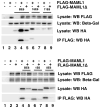Cutaneous papillomavirus E6 oncoproteins associate with MAML1 to repress transactivation and NOTCH signaling
- PMID: 22249263
- PMCID: PMC3330202
- DOI: 10.1038/onc.2011.589
Cutaneous papillomavirus E6 oncoproteins associate with MAML1 to repress transactivation and NOTCH signaling
Abstract
Papillomavirus E6 oncoproteins associate with LXXLL motifs on target cellular proteins to alter their function. Using a proteomic approach, we found the E6 oncoproteins of cutaneous papillomaviruses Bovine Papillomavirus Type 1 (BPV-1) E6 and human papillomavirus (HPV) types 1 and 8 (1E6 and 8E6) associated with the MAML1 transcriptional co-activator. All three E6 proteins bind to an acidic LXXLL motif at the carboxy-terminus of MAML1 and repress transactivation by MAML1. MAML1 is best known as the co-activator and effector of NOTCH-induced transcription, and BPV-1 E6 represses synthetic NOTCH-responsive promoters, endogenous NOTCH-responsive promoters, and is found in a complex with MAML1 in stably transformed cells. BPV-1-induced papillomas show characteristics of repressed NOTCH signal transduction, including suprabasal expression of integrins, talin and basal type keratins, and delayed expression of the NOTCH-dependent HES1 transcription factor. These observations give rise to a model whereby papillomavirus oncoproteins, including BPV-1 E6, and the cancer-associated HPV-8 E6 repress NOTCH-induced transcription, thereby delaying keratinocyte differentiation.
Conflict of interest statement
Figures








Similar articles
-
Association of papillomavirus E6 proteins with either MAML1 or E6AP clusters E6 proteins by structure, function, and evolutionary relatedness.PLoS Pathog. 2017 Dec 27;13(12):e1006781. doi: 10.1371/journal.ppat.1006781. eCollection 2017 Dec. PLoS Pathog. 2017. PMID: 29281732 Free PMC article.
-
Cutaneous β-human papillomavirus E6 proteins bind Mastermind-like coactivators and repress Notch signaling.Proc Natl Acad Sci U S A. 2012 Jun 5;109(23):E1473-80. doi: 10.1073/pnas.1205991109. Epub 2012 Apr 30. Proc Natl Acad Sci U S A. 2012. PMID: 22547818 Free PMC article.
-
Cutaneous HPV8 and MmuPV1 E6 Proteins Target the NOTCH and TGF-β Tumor Suppressors to Inhibit Differentiation and Sustain Keratinocyte Proliferation.PLoS Pathog. 2017 Jan 20;13(1):e1006171. doi: 10.1371/journal.ppat.1006171. eCollection 2017 Jan. PLoS Pathog. 2017. PMID: 28107544 Free PMC article.
-
Papillomavirus E6 oncoproteins.Virology. 2013 Oct;445(1-2):115-37. doi: 10.1016/j.virol.2013.04.026. Epub 2013 May 24. Virology. 2013. PMID: 23711382 Free PMC article. Review.
-
Inhibition of TGF-β and NOTCH Signaling by Cutaneous Papillomaviruses.Front Microbiol. 2018 Mar 8;9:389. doi: 10.3389/fmicb.2018.00389. eCollection 2018. Front Microbiol. 2018. PMID: 29568286 Free PMC article. Review.
Cited by
-
Comparative structural studies on Bovine papillomavirus E6 oncoproteins: Novel insights into viral infection and cell transformation from homology modeling and molecular dynamics simulations.Genet Mol Biol. 2024 Aug 9;47(3):e20230346. doi: 10.1590/1678-4685-GMB-2023-0346. eCollection 2024. Genet Mol Biol. 2024. PMID: 39136577 Free PMC article.
-
E6 proteins from high-risk HPV, low-risk HPV, and animal papillomaviruses activate the Wnt/β-catenin pathway through E6AP-dependent degradation of NHERF1.PLoS Pathog. 2019 Apr 19;15(4):e1007575. doi: 10.1371/journal.ppat.1007575. eCollection 2019 Apr. PLoS Pathog. 2019. PMID: 31002735 Free PMC article.
-
Multiple regions of E6AP (UBE3A) contribute to interaction with papillomavirus E6 proteins and the activation of ubiquitin ligase activity.PLoS Pathog. 2020 Jan 23;16(1):e1008295. doi: 10.1371/journal.ppat.1008295. eCollection 2020 Jan. PLoS Pathog. 2020. PMID: 31971989 Free PMC article.
-
High NOTCH1 mRNA Expression Is Associated with Better Survival in HNSCC.Int J Mol Sci. 2018 Mar 13;19(3):830. doi: 10.3390/ijms19030830. Int J Mol Sci. 2018. PMID: 29533972 Free PMC article.
-
The human papillomavirus type 8 E6 protein interferes with NOTCH activation during keratinocyte differentiation.J Virol. 2013 Apr;87(8):4762-7. doi: 10.1128/JVI.02527-12. Epub 2013 Jan 30. J Virol. 2013. PMID: 23365452 Free PMC article.
References
-
- zur Hausen H. Papillomaviruses in the causation of human cancers - a brief historical account. Virology. 2009 Feb 20;384(2):260–5. - PubMed
-
- Orth G. Genetics of epidermodysplasia verruciformis: Insights into host defense against papillomaviruses. Semin Immunol. 2006 Dec;18(6):362–74. - PubMed
-
- Green H. Terminal differentiation of cultured human epidermal cells. Cell. 1977 Jun;11(2):405–16. - PubMed
-
- Adams JC, Watt FM. Fibronectin inhibits the terminal differentiation of human keratinocytes. Nature. 1989 Jul 27;340(6231):307–9. - PubMed
Publication types
MeSH terms
Substances
Grants and funding
LinkOut - more resources
Full Text Sources
Research Materials

